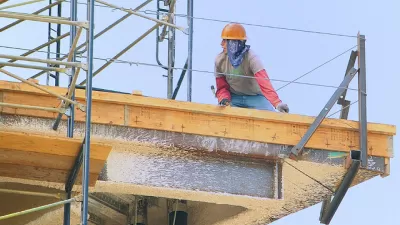Measure S gives city leaders a moderately satisfying smack across the face. As satisfying as that may be, Measure S is remarkably bad planning and development policy at the expense of the vast majority of Angelinos.

On March 7, 2017, Los Angeles residents will vote on a number of local ballot measures, from regulating marijuana dispensaries to funding homeless shelter construction. One of those measures is Measure S, a ballot measure touted by its supporters as a way to rein in development and a city hall they believe is too friendly to developers (an assertion anyone who has ever tried to build in Los Angeles would argue otherwise, but I digress…)
Let's stipulate that Los Angeles does a poor job at updating its planning documents. The city's general plan has not been updated for decades. Many of the city's 35 community plans that make up the general plan's land use element are equally as outdated. Measure S gives city leaders a moderately satisfying smack across the face, like a Batman and Robin meme. But as satisfying as that may be, it doesn't take away from the fact that Measure S is simply bad planning and development policy.
What is Measure S?
Measure S is a ballot initiative backed by the head of the AIDS Healthcare Foundation, Michael Weinstein, under the group named "Coalition to Preserve Los Angeles." The measure imposes a two-year moratorium, prohibiting development projects that require a general plan amendment, zone change, or height district change. The measure would thus prohibit any development approval that results in a larger project (more density, height, etc.) or a different use than permitted by the original zoning or land use designation. The moratorium would end after either a) the city adopts an updated general plan framework element as well as the text of at least one of the 35 community plans, or b) the end of the two-year period, whichever comes first.
More ominously, and less discussed than the moratorium, Measure S amends Los Angeles' Charter to require all future potential general plan amendments meet a minimum threshold of 15 acres, and require all future plan updates to limit increases in density based on the existing average density of the planning area.
Plenty has been said of the motives behind Measure S's main backers, including that of AIDS Healthcare Foundation CEO, Michael Weinstein, using Measure S as a way to get back at the city for approving a development project across the street from his office with a view, or how the measure is a type of municipal level xenophobia, akin to Trumpian style immigration reform (hyperbole no doubt, but not by much). Opinions aside, we can state equivocally one point: The overall purpose of Measure S is to stop development cold.
Measure S stops development and little else
It's clear that the purpose of Measure S's two-year moratorium is to stop development. However, the provision of the 15-acre minimum requirement for general plan amendments betrays the true desire of the Measure to stop development more generally.
Proponents of Measure S argue that past and current approval of amendments of such smaller geographic areas are fundamentally "spot zoning," or the re-zoning of individual parcels for the benefit of the individual property owner and at the expense of the general plan and consistency of the zoning code. It is not my intention to discuss the legal minutiae of spot zoning in this post. Nevertheless, as a matter of policy, Los Angeles upzones a very small portion of its land on net. UCLA's Ziman Center for Real Estate published an "Economic Letter" [pdf] showing that Los Angeles had upzoned 225 acres and downzoned 212 acres (out of over 300,000 acres) between 2004 and 2012, or less than two-tenths of one (ONE!) percent each year. Hardly the rampant "Manhattanization" proponents of Measure S decry. In his 700-page dissertation, Greg Morrow, a PhD student at UCLA in 2013, showed how Los Angeles was zoned to permit enough density to accommodate 10 million people back in 1960, and was later forced to downzone, by the same type of interests pushing for Measure S, to a density that could accommodate approximately 4.3 million in 2010.
Developers request general plan amendments and zone changes because Los Angeles' zoning code and general plan are archaic governing documents designed for an urban form that emerged over a century ago. Proponents of Measure S wish to maintain that urban form. It is a classic fight between the old planning paradigm of sprawl and car reliance against the new paradigm of sustainable higher-density infill. Measure S uses brute force to attack the proverbial symptoms of the disease, rather than the cause—that what is wrong with planning and development in Los Angeles is the request for exemption from code requirements, rather than the code itself. Sure, Measure S demands updates to the plans, but by limiting land area as well as the degree to which professionals can plan for an increasing population, Measure S essentially demands the city remain stagnant in outdated zoning practices for the foreseeable future.
General plan amendments don't necessarily cause displacement
Proponents of Measure S, and most development to a larger degree, assert that the moratorium and increased difficulty in obtaining discretionary approvals will benefit communities fighting change, such as gentrification. However, these arguments callously ignore the reality of which development projects actually displace residents, and which projects are simply new constructions. Consider exactly what is a general plan amendment and zone change.
As described in Measure S, a general plan amendment is fundamentally an action by a city to permit a use where one was previously prohibited. Mixed-uses notwithstanding, residential uses are not typically permitted in commercial or industrial uses. Projects requesting a change of land use for a warehouse in an industrial zone, as an example, to permit the development of new apartments displaces no residents because no residents would have been permitted to live in the warehouse to begin with. The same can be said of commercial space. If old retail storefronts are bought and a land use request is made to permit construction of a mixed-use development with residential above ground floor retail, the displacement of retail tenants is not the same as displacement of residential tenants. In fact, such a mixed-use scenario actually preserves retail square footage and adds residential units without resident displacement. Of course, what is more common, particularly in Los Angeles, is the acquisition and development of underutilized infill properties, such as parking lots or parking structures. These projects will seek to change the underlying land use designation from those designated for parking, to those that permit a much more flexible array of uses, such as commercial or residential. The claim by Measure S proponents that general plan amendments push people out of their homes is demonstrably false.
Measure S actually hurts under-privileged communities
The far more common development project that results in residential displacement is property redevelopment. Redevelopment projects, such as modification to an existing buildings interior or exterior, is largely a by-right process, requiring little-to-no discretionary approval to complete, and even more rarely requiring a general plan amendment or other large entitlements. These by-right projects include conversion of an apartment building to condominiums, or the improvements to existing residential buildings that lead to evictions of low-income renters and increasing rents. What’s more fundamental to the ignorance of Measure S is that these types of projects don’t necessarily have to be consistent with the existing zoning code or general plan because of the principle of legal non-conforming, otherwise known as "grandfathering."
Grandfathering permits existing structures and uses to continue even though they do not comply with the existing zoning code on items such as required parking, yards, and setbacks, as well as height and density. Measure S does nothing to stop a developer from buying an existing apartment building and converting those units to high-end condos—a by-right process in most jurisdictions. We can only assume those omissions were intentional. After all, supporters of Measure S assert two contradictory statements that general plan amendments and zone changes are a rampant problem across Los Angeles, while simultaneously asserting on their website that the Measure it will impact only 5-percent of all permits. Residential displacement is not the concern of Measure S, leaving lower-income households who cannot afford higher rents resulting from redevelopment, or the inability to meet demand with increased unit supply, to continue to fend for themselves.
Measure S is immature policy for a problem in need of adult solutions
Measure S would be devastating to efforts trying to solve our current housing cost crisis, let alone efforts to plan a city that is diverse and sustainable. The Los Angeles Times accurately calls Measure S a "childish middle finger to city hall." I, and many others in the field of planning and development, can agree that Los Angeles' planning documents are in need of reform and update. Yes there are a number of other changes proposed in the ballot language, such as requiring the city to prepare environmental impact reports (instead of hiring developer-chosen consultants), and prohibiting the city from granting parking reductions below one-third of current code requirements. Nevertheless, it cannot be ignored that the first and foremost intent of the Measure is to stop development, not simply for a period of two years, but more permanently, sacrificing the vast majority of Angelinos who are less concerned about the view from the high-floor corner office they don’t have.

Alabama: Trump Terminates Settlements for Black Communities Harmed By Raw Sewage
Trump deemed the landmark civil rights agreement “illegal DEI and environmental justice policy.”

Study: Maui’s Plan to Convert Vacation Rentals to Long-Term Housing Could Cause Nearly $1 Billion Economic Loss
The plan would reduce visitor accommodation by 25% resulting in 1,900 jobs lost.

Planetizen Federal Action Tracker
A weekly monitor of how Trump’s orders and actions are impacting planners and planning in America.

Wind Energy on the Rise Despite Federal Policy Reversal
The Trump administration is revoking federal support for renewable energy, but demand for new projects continues unabated.

Passengers Flock to Caltrain After Electrification
The new electric trains are running faster and more reliably, leading to strong ridership growth on the Bay Area rail system.

Texas Churches Rally Behind ‘Yes in God’s Back Yard’ Legislation
Religious leaders want the state to reduce zoning regulations to streamline leasing church-owned land to housing developers.
Urban Design for Planners 1: Software Tools
This six-course series explores essential urban design concepts using open source software and equips planners with the tools they need to participate fully in the urban design process.
Planning for Universal Design
Learn the tools for implementing Universal Design in planning regulations.
Caltrans
Smith Gee Studio
Institute for Housing and Urban Development Studies (IHS)
City of Grandview
Harvard GSD Executive Education
Toledo-Lucas County Plan Commissions
Salt Lake City
NYU Wagner Graduate School of Public Service





























